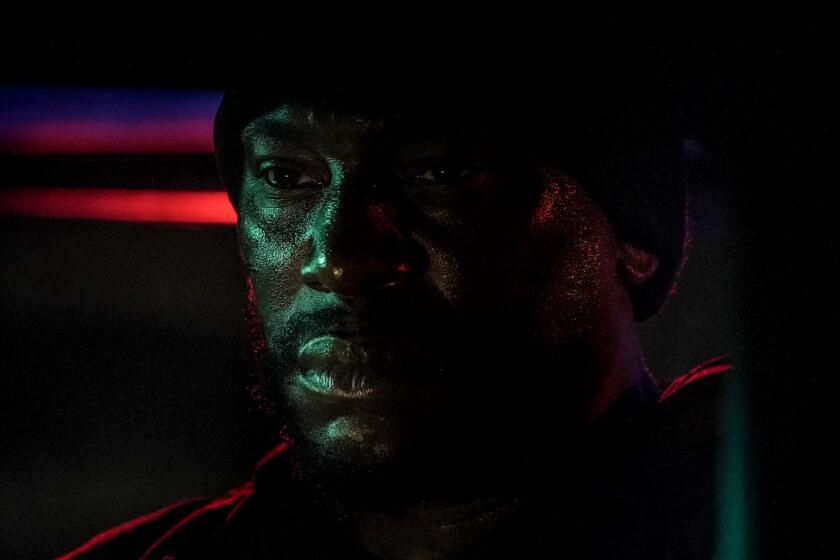UCLA film series touts William Wellman, ‘Hollywood Rebel’
In the lexicon of classic Hollywood, the letter W looms especially large. But of all the directors in that distinguished group, including Raoul Walsh, Billy Wilder, Orson Welles and William Wyler, no one is harder to define than William Wellman, a filmmaker who went his own way.
Often neglected and sometimes maligned (critic Andrew Sarris listed him as “Less Than Meets the Eye” in his landmark “The American Cinema”), Wellman is starting to get his due. The UCLA Film & Television Archive begins a series called “William A. Wellman, Hollywood Rebel” on Friday night at the Hammer Museum’s Billy Wilder Theater in Westwood with a double bill of two of his best-known films, the Carole Lombard screwball comedy “Nothing Sacred” and the 1937 version of “A Star Is Born.”
The 21 films in the series were designated by the director’s son, William Wellman Jr. (author of a new biography of his father called “Wild Bill Wellman”) as the filmmaker’s favorites. Looked at as a group, these works reveal someone who over the course of a long career was consistent by his own lights.
Though Wellman’s name may have faded a bit, his accomplishments have not. It was Wellman who directed 1927’s “Wings,” the first film to win the best picture Academy Award. It was Wellman who directed the celebrated scene in “The Public Enemy” where James Cagney squashed a half-grapefruit in Mae Clarke’s face.
It was Wellman who was instrumental in the careers not only of Cagney but also Gary Cooper, Clark Gable, Robert Mitchum and all the way up to Clint Eastwood. And it was Wellman who used to land his aircraft on Douglas Fairbanks’ polo field for weekend visits.
That flying wasn’t a stunt. Wellman had been a decorated American flier for the Lafayette Escadrille in World War I, and that experience added a marvelous authenticity to the dogfights (shot in the skies above San Antonio) that made “Wings” an Oscar-winning success.
The camaraderie of that film, the pleasures of men being in the company of men, frequently characterized Wellman’s films. His crisp 1939 “Beau Geste,” starring Gary Cooper as one of three siblings who enlist in the French Foreign Legion, begins with a putative Arab proverb that says it all: “The love of brother for brother is as steadfast as the stars....”
Also a constant in many of Wellman’s films was a passion for America, which led him to sympathize with the underdog because he wanted this country to be all that it could be.
One result was 1943’s Henry Fonda-starring “The Ox-Bow Incident,” an anti-lynching epic considered so strong in its day that one contemporary critic called it “shocking in its revelation of human baseness.”
Two years later, Wellman did one of his best-regarded films, “The Story of G.I. Joe,” based on the work of celebrated war correspondent Ernie Pyle (who died in combat before he could see the finished film). It gave Robert Mitchum his only Oscar nomination, as a laconic officer, and its empathy for ordinary soldiers caused critic James Agee, no pushover for Hollywood, to call it “an act of heroism.”
While not all of Wellman’s films are fated to compel audiences today, the ones that remain the strongest tend to be the earlier ones, starting with 1928’s rarely seen silent, “Beggars of Life.”
“Beggars” stars Louise Brooks, distinctive hairstyle and all, as a young woman who murders her foster father in the film’s opening minutes as he attempts to assault her. She meets a young hobo (Richard Arlen) and they take to the road in an early manifestation of Wellman’s sympathy for the dispossessed.
The director’s visual vigor and energy made him a natural for pre-Code sound melodramas, and UCLA has some of the best. These include 1931’s “Night Nurse,” starring Barbara Stanwyck and featuring Clark Gable as a cleanshaven villain, and 1933’s “Midnight Mary,” which starred Loretta Young as a young woman of whom it is said “men can’t get her out of their minds, their senses, their blood!”
Even more of a pre-Code classic is the 1931 gangster film “The Public Enemy,” which galvanized Cagney’s career when he played what the New York Herald Tribune called “the most ruthless, unsentimental appraisal of the meanness of a petty killer the cinema has yet devised.”
Wellman’s feeling for those whom society had cast off was especially pronounced in a pair of socially conscious films from 1933 that were remarkable in their day and continue to be so: “Heroes for Sale” and “Wild Boys of the Road.”
“Heroes for Sale” stars sad-eyed Richard Barthelmess as a World War I veteran who gets a morphine addiction instead of the medals he deserves and then experiences bread lines, labor unrest and the scrutiny of the sour-faced Red Squad. An impressively honest film, “Heroes for Sale” actively explores the idea that Depression America was close to total collapse.
“Wild Boys of the Road,” advertised as dealing with “the abandoned generation” starred Frankie Darro and Dorothy Coonan (soon to marry her director) as one of a small army of young people forced to become vagabonds because of impoverished parents. Basically good kids, they are overwhelmed by the miasma of joblessness and end up fighting anarchic pitched battles with unfeeling police.
Also exhibiting empathy for those fighting long odds, in this case young people trying to make it in Hollywood, is the 1937 version of “A Star Is Born,” which won Wellman his only Oscar, for co-writing the story. Often overshadowed by the Judy Garland / James Mason remake, this Janet Gaynor / Fredric March original, shot in delicate early Technicolor, is every bit as affecting as any of its later versions.
One of the best of Wellman’s postwar films was 1948’s “Yellow Sky,” a taut and involving “adult western” starring a fatalistic Gregory Peck that takes place in both a deserted ghost town and the salt flats of Death Valley, a location so hot the horses weren’t allowed to work more than three hours a day.
Just 30 years old when “Wings” came out, Wellman told a newspaper reporter that it would only be “two or three more years of directing for me, and then I am going to travel and enjoy life.” It didn’t quite work out that way, and this fine UCLA series makes us glad it didn’t.
Follow Classic Hollywood on Facebook
More to Read
Only good movies
Get the Indie Focus newsletter, Mark Olsen's weekly guide to the world of cinema.
You may occasionally receive promotional content from the Los Angeles Times.










